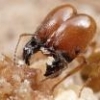- Formiculture.com
- Forums
- Gallery
- Members
- Member Map
- Chat
11 replies to this topic
#1
 Offline
-
Posted September 12 2016 - 4:49 PM
Offline
-
Posted September 12 2016 - 4:49 PM
I have a mealworm farm (Tenebrio molitor), and a few minutes ago I found one beetle that is MUCH smaller than the average darling beetle in my farm. The following picture shows it next to an average sized beetle. Can anyone tell me why?
#2
 Offline
-
Posted September 12 2016 - 4:53 PM
Offline
-
Posted September 12 2016 - 4:53 PM

#3
 Offline
-
Posted September 12 2016 - 5:32 PM
Offline
-
Posted September 12 2016 - 5:32 PM
I dunno, (probably just a stunted specimen), but it sort of reminds me of some of the wild darling beetles I find by peeling bark off of logs. I read somewhere that wild T. molitor are found under bark, which makes me wonder if some of those species could potentially be farmed the same way and perhaps be faster growing, hardier or otherwise better alternatives to the common mealworm.
#4
 Offline
-
Posted September 12 2016 - 5:52 PM
Offline
-
Posted September 12 2016 - 5:52 PM
Could be Tribolium castaneum.
If you've enjoyed using my expertise and identifications, please do not create undue ecological risk by releasing your ants. The environment which we keep our pet insects is alien and oftentimes unsanitary, so ensure that wild populations stay safe by giving your ants the best care you can manage for the rest of their lives, as we must do with any other pet.
Exotic ants are for those who think that vibrant diversity is something you need to pay money to see. It is illegal to transport live ants across state lines.
----
Black lives still matter.
#5
 Offline
-
Posted September 12 2016 - 6:25 PM
Offline
-
Posted September 12 2016 - 6:25 PM
#6
 Offline
-
Posted September 12 2016 - 6:44 PM
Offline
-
Posted September 12 2016 - 6:44 PM
I dunno, (probably just a stunted specimen), but it sort of reminds me of some of the wild darling beetles I find by peeling bark off of logs. I read somewhere that wild T. molitor are found under bark, which makes me wonder if some of those species could potentially be farmed the same way and perhaps be faster growing, hardier or otherwise better alternatives to the common mealworm.
I've had the exact same thought! Someone should definitely try that!
#7
 Offline
-
Posted September 12 2016 - 6:47 PM
Offline
-
Posted September 12 2016 - 6:47 PM
I don't think so. I considered that earlier, but it looked a lot more like T. molitor. Plus, I can't see how any other beetles could possibly get into my culture. It's on the second floor of a suburban house.Could be Tribolium castaneum.
Edited by MC Wren, September 12 2016 - 6:47 PM.
#8
 Offline
-
Posted September 12 2016 - 7:21 PM
Offline
-
Posted September 12 2016 - 7:21 PM
How long have you had the culture? Tenebrio obscurus is another option. Do you know if the beetle eclosed recently?
- MC Wren likes this
If you've enjoyed using my expertise and identifications, please do not create undue ecological risk by releasing your ants. The environment which we keep our pet insects is alien and oftentimes unsanitary, so ensure that wild populations stay safe by giving your ants the best care you can manage for the rest of their lives, as we must do with any other pet.
Exotic ants are for those who think that vibrant diversity is something you need to pay money to see. It is illegal to transport live ants across state lines.
----
Black lives still matter.
#9
 Offline
-
Posted September 13 2016 - 3:13 AM
Offline
-
Posted September 13 2016 - 3:13 AM
Assuming it just recently turned into a beetle it looks like just a "not fully darkened" small Mealworm beetle, size differences happen quite a bit in my Colony.
#10
 Offline
-
Posted September 13 2016 - 12:36 PM
Offline
-
Posted September 13 2016 - 12:36 PM
I've had the culture for a while now... Probably about 6 months.How long have you had the culture? Tenebrio obscurus is another option. Do you know if the beetle eclosed recently?
#11
 Offline
-
Posted September 13 2016 - 12:37 PM
Offline
-
Posted September 13 2016 - 12:37 PM
Also, it must have eclosed somewhat recently, since it's still brown.How long have you had the culture? Tenebrio obscurus is another option. Do you know if the beetle eclosed recently?
#12
 Offline
-
Posted September 14 2016 - 5:20 AM
Offline
-
Posted September 14 2016 - 5:20 AM
I was asking because some of the Tribolium spp. are naturally brown/red.
If you've enjoyed using my expertise and identifications, please do not create undue ecological risk by releasing your ants. The environment which we keep our pet insects is alien and oftentimes unsanitary, so ensure that wild populations stay safe by giving your ants the best care you can manage for the rest of their lives, as we must do with any other pet.
Exotic ants are for those who think that vibrant diversity is something you need to pay money to see. It is illegal to transport live ants across state lines.
----
Black lives still matter.
Also tagged with one or more of these keywords: mealworm, beetle
Ant Keeping →
General Ant Keeping →
Moldy mealworm farmStarted by DinoH , Jul 30 2023 |
|

|
||
Ant Keeping →
General Ant Keeping →
Predatory mites on rhino beetles?Started by UtahAnts , Oct 12 2022 |
|

|
||
Anting →
General Anting →
Camponotus Albosparsus not really eatingStarted by Iqyxthegamer , Jan 14 2021 |
|

|
||
Off-Topic →
General Off-Topic →
Beautiful FindStarted by Nathant2131 , Jun 4 2017 |
|

|
||
Ant Keeping →
General Ant Keeping →
Mite Emergency!Started by Connectimyrmex , Jan 26 2017 |
|

|
1 user(s) are reading this topic
0 members, 1 guests, 0 anonymous users




















